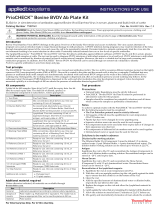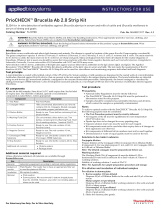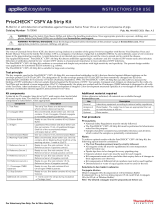Page is loading ...

INSTRUCTIONS FOR USE
For Veterinary Use Only. For In Vitro Use Only.
PrioCHECK™ Ruminant BVD & BD p80 Ab Serum Kit
Immunoenzymatic test for specific detection of anti-p80 BVDV and BDV antibodies in
ruminant serum.
Catalog Number BVDI5
Doc. Part No. 100020235 Pub. No. MAN0009388 Rev. A.0
Technology
Species
Sample matrix
Test type
Protocol
Single-well blocking ELISA
-Strip plates
Bovine
Ovine Serum Individual
Short incubation
Long incubation
Pool
Long incubation
WARNING! Read the Safety Data Sheets (SDSs) and follow the handling instructions.
Wear appropriate protective eyewear, clothing, and gloves.
Safety Data Sheets (SDSs) are available from
thermofisher.com/support.
WARNING! POTENTIAL BIOHAZARD. Read the biological hazard safety information at this
product’s page at thermofisher.com. Wear appropriate protective eyewear, clothing, and gloves.
General information
Bovine Viral Diarrhea Virus (BVDV) is a virus belonging to the Pestivirus genus of the Flaviviridae family.
Two other animal viruses belong to the same Pestivirus genus: Border Disease Virus (BDV) in sheep and
Classic Swine Fever (CSF) in pigs.
BVDV is one of the most widespread pathogenic viruses in livestock, causing significant losses in the milk
and meat industries worldwide.
The virus crosses the placenta of infected gestating cows, causing reproductive losses due to abortions,
still-born calves, and calves that die early. Some surviving calves are immunotolerant to the virus, and
these animals excrete large quantities of infectious virus for the rest of their lives. It is important to
identify these carrier animals to break the cycle of infection in the herd. Carrier animals often die of
mucosal disease in their first two years of life.
Diagnosis of BVDV through detection of specific antibodies has a number of applications:
•Detection of viral circulation in livestock
•Pre-detection of immunotolerant, persistently infected animals (PI)
•Monitoring of herds after elimination of the PI
•Implementation of epidemiological investigations
The Applied Biosystems™ PrioCHECK™ Ruminant BVD & BD p80 Ab Serum Kit can be used on the
following samples: individual and pooled bovine and ovine sera to detect anti-BVDV and anti-BDV
antibodies.
Procedure overview
The test is based on the principle of a Blocking ELISA (competition assay).
1. The samples and controls are added to the BVD/BD antigen (Ag)-coated plate. Any specific BVD/BD
antibodies bind to the Ag.
2. After washing, a conjugate (anti-p80 monoclonal antibody) labeled with peroxidase is added, binding
to the unbound p80 that remains in the plate.
3. The unbound conjugate is eliminated by washing before the addition of a chromogenic substrate. A
blue color results from substrate oxidation by the peroxidase in the conjugate.
4. After stopping the reaction, the color turns yellow. The results are read by an ELISA plate reader.
Positive samples produce relatively weak to no color.

2 PrioCHECK™ Ruminant BVD & BD p80 Ab Serum Kit Instructions for Use
Kit contents and storage
Component Description
Quantity
(480 tests)
Storage
1 - Coated microplate BVD
BVD-coated microplate, 12 strips of 8 wells
5 units
5±3°C
(1)
2a - Serum Negative C. BVD
BVD negative control (NC)
1 mL
5±3°C
3a - Serum Positive C. BVD
BVD positive control (PC)
1 mL
4 - Conjugate BVD
Conjugate BVD, anti-p80 HRP (pink)
60 mL
A - Wash (10x)
Wash solution, 10x concentrate
250 mL
B - Sample DB BVD
BVD sample dilution buffer (green)
60 mL
C - Substrate
Substrate solution
60 mL
D - Stop
Stop solution
60 mL
Adhesive plate covers
10
RT
(2)
(1) Unused strips can be stored in the sealed pouch with desiccant (supplied with the kit) at 5±3°C until the kit’s expiry date.
(2) Room temperature
Materials required but not provided
Unless otherwise indicated, all materials are available through thermofisher.com.
Single- and multi-channel micropipettes
Disposable pipette tips
Distilled or deionized water
Microplate incubator (37±2°C)
Disposable containers
ELISA reader equipped with a 450 nm filter or 450 and 620 nm filters
Important procedural guidelines
•Do not mix reagents from different kit batches.
•Avoid contaminating the reagents by using single-use sampling equipment.
•Do not pipette reagents by mouth.
Preparation of samples
Fresh, refrigerated serum (8 days at 5±3°C) or frozen serum (1 year at < −16°C) can be used.
The samples are homogenized in advance.
•Individual sera and controls are tested at a 1:10 dilution (short or long incubation).
•Pooled sera from a group of animals raised on the same farm (long incubation only):
-For epidemiological use aimed at evaluating positive prevalence in homogeneous groups of
animals (pool of 2 to 20 sera), the pooled sera and controls are tested at a 1:20 dilution.
-For diagnostic use aimed at detecting at least one seropositive animal in a pool of 2 to 10 sera, the
pooled sera and controls are tested at a 1:2 dilution.
NOTE: The use of an internal tracer is highly recommended for each test series. An internal reference
(Cat. No. RBVD) is available.
Preparation of reagents
•Reagents 1 - Coated microplate BVD, B - Sample DB BVD, 4 - Conjugate BVD, C - Substrate and
D - Stop are ready for use.
•Reagents 2a - Serum Negative C. BVD and 3a - Serum Positive C. BVD should be tested as samples.
•A - Wash (10x) solution should be diluted 1:10 in distilled/deionized water.
Example: for one strip: 2 mL of A - Wash (10x) solution in 18 mL of water; for one plate: 25 mL of
A - Wash (10x) solution in 225 mL of water.
Mix after diluting. The diluted Wash solution can be stored for 1 month at 5±3°C.
NOTE: Due to the high salt concentration, crystals may form in the A - Wash (10x) solution. Shake the
bottle to dissolve any crystals prior to dilution.

PrioCHECK™ Ruminant BVD & BD p80 Ab Serum Kit Instructions for Use 3
Perform the ELISA test
NOTE: Bring the reagents to room temperature (21±4°C) before performing the test. The tolerance range
for incubation times is ±10%. The use of disposable containers is recommended for distribution of
reagents.
1. Distribution of samples and controls
A. Individual serum samples (at a 1:10 dilution):
•Add 10 µL of reagent 3a - Serum Positive C. BVD to wells A1 and B1 (for example).
•Add 10 µL of reagent 2a - Serum Negative C. BVD to wells C1 and D1 (for example).
•Add 10 µL of the serum to be analyzed to the following wells.
•Add 90 µL of reagent B - Sample DB BVD to each well containing the samples and controls.
B1. Pooled serum samples - Epidemiological use (at a 1:20 dilution):
•Add 5 µL of reagent 3a - Serum Positive C. BVD to wells A1 and B1 (for example).
•Add 5 µL of reagent 2a - Serum Negative C. BVD to wells C1 and D1 (for example).
•Add 5 µL of the pooled serum to be analyzed to the following wells.
•Add 95 µL of reagent B - Sample DB BVD to each well containing the samples and controls.
B2. Pooled serum samples - Diagnostic use (at a 1:2 dilution):
•Add 50 µL of reagent 3a - Serum Positive C. BVD to wells A1 and B1 (for example).
•Add 50 µL of reagent 2a - Serum Negative C. BVD to wells C1 and D1 (for example).
•Add 50 µL of the pooled serum to be analyzed to the following wells.
•Add 50 µL of reagent B - Sample DB BVD to each well containing the samples and controls.
Gently shake the plate, then cover it with an adhesive plate cover.
Individual serum analysis: Incubate the plate overnight (16 to 18 hours) at 5±3°C or 1 hour at 37±2°C.
NOTE: The kit has better detectability with long incubation.
Pooled sera analysis: Incubate the plate overnight (16 to 18 hours) at 5±3°C
2. Washing steps
Empty the plate and perform 4 washes with the diluted Wash solution (see “Preparation of reagents”)
using 300 µL per well. Empty and tap the plate on absorbent paper to eliminate any traces of liquid.
Washes can be performed either manually or automated using a plate washer. Do not allow the plate to
dry out.
3. Conjugate distribution
Add 100 µL of reagent 4 - Conjugate BVD to each well. Gently shake the plate, and cover the plate using a
new adhesive plate cover. Incubate the plate for 1 hour at 37±2°C.
4. Washing steps
Repeat the “Washing steps” as described above.
5. Test development
Add 100 µL of solution C - Substrate to each well. Gently shake the plate for 2 seconds. Incubate for
10 minutes at room temperature (21±4°C) and in darkness. Do not cover the plate.
Add 100 µL of solution D - Stop to each well and in the same order as solution C - Substrate. Gently
shake the plate for 2 seconds.
6. Reading
Dry the bottom of the plates with a soft tissue to remove any dust. Read the plate within 30 minutes of
stopping the reaction at 450 nm (monochromatic) or at 450–620 nm (bichromatic).
Calculation
Calculate the average OD of the PC (ODm PC), and that of the NC (ODm NC).
For each sample, calculate the percent inhibition (% Inh):
% Inh = [ (ODm NC − OD Sample) / ODm NC ] × 100
NOTE: For negative samples, % Inh may be < 0.

thermofisher.com/support | thermofisher.com/askaquestion
thermofisher.com
4 April 2017
Validation
The test is validated if:
% Inh PC > 60% and ODm NC > 0.650
Interpretation of results
Table 1 Individual serum
Results
Quantitative interpretation
Qualitative interpretation
% Inh < 50
–
Negative
50 ≤ % Inh < 80
+
Weak positive
% Inh ≥ 80
++
Strong positive
Table 2 Pool of 2 to 20 sera - Protocol 1:20 - Epidemiological use
Results
% Seroprevalence
Interpretation
% Inh < 65
The positive prevalence of anti-p80
antibodies is low, generally < 50%
No or low risk of viral circulation
% Inh ≥ 65
The positive prevalence of anti-p80
antibodies is high, generally > 50%
Suspicion of viral passage. High risk of
presence of PI or transient viremic animals
Table 3 Pool of 2 to 10 sera - Protocol 1:2 - Diagnostic use
Results
Qualitative interpretation
Status
% Inh < 30
Negative
Not infected
% Inh ≥ 30
Positive
Recently infected or infected
Documentation and support
Customer and technical support
Technical support: visit
thermofisher.com/askaquestion
Visit thermofisher.com/support for the latest in
services and support, including:
•Worldwide contact telephone numbers
•Order and web support
•User guides, manuals, and protocols
•Certificates of Analysis
•Safety Data Sheets (SDSs; also known as MSDSs)
NOTE: For SDSs for reagents and chemicals from
other manufacturers, contact the manufacturer.
Limited product warranty
Life Technologies Corporation and/or its
affiliate(s) warrant their products as set forth in the
Life Technologies' General Terms and Conditions
of Sale found on Life Technologies' website at
www.thermofisher.com/us/en/home/global/
terms-and-conditions.html. If you have any
questions, please contact Life Technologies at
thermofisher.com/support.
Prionics Lelystad B.V. | Platinastraat 33 | 8211 AR
Lelystad | The Netherlands
Translated from the French Pub. No. MAN0007704 Rev. A.0.
The information in this guide is subject to change without notice.
DISCLAIMER: TO THE EXTENT ALLOWED BY LAW, LIFE
TECHNOLOGIES AND/OR ITS AFFILIATE(S) WILL NOT BE LIABLE
FOR SPECIAL, INCIDENTAL, INDIRECT, PUNITIVE, MULTIPLE, OR
CONSEQUENTIAL DAMAGES IN CONNECTION WITH OR ARISING
FROM THIS DOCUMENT, INCLUDING YOUR USE OF IT.
Revision history: Pub. No. MAN0009388 (English)
Rev.
Date
Description
A.0 4 April 2017
Updated to the current document
template, with associated updates to
the warranty, trademarks, and logos.
1.0
4 October 2013
Baseline for revision history
Limited Use Label License No. 473: Veterinary Diagnostic Assay.
The purchase of this product conveys to the purchaser the limited,
non-transferable right to use the purchased amount of the product
only to perform veterinary diagnostic services including reporting
the results of such services for a fee, and internal research for the
sole benefit of the purchaser. No right to resell, repackage, or
distribute this product, or any of its components, is conveyed ex-
pressly, by implication, or by estoppel. For information on obtaining
additional rights, please contact outlicensing@lifetech.com or
Out Licensing, Life Technologies, 5791 Van Allen Way, Carlsbad,
California 92008.
©2017 Thermo Fisher Scientific Inc. All rights reserved. All
trademarks are the property of Thermo Fisher Scientific and its
subsidiaries unless otherwise specified.
/









